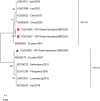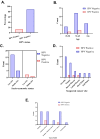Detection of high-risk human papillomavirus genotypes 58 and 59 among oral squamous cell carcinoma patients
- PMID: 40731008
- PMCID: PMC12309181
- DOI: 10.1186/s13027-025-00687-7
Detection of high-risk human papillomavirus genotypes 58 and 59 among oral squamous cell carcinoma patients
Abstract
Oropharyngeal squamous cell carcinoma (OPSCC), a type of head and neck cancer (HNC), represents a major global health issue contributing to substantial morbidity and mortality. Human papillomavirus (HPV) is an established oncogenic virus and is among the major causes for OPSCC. Although HPV has been identified as a risk factor for oral squamous cell carcinoma (OSCC). Limited information exists on its current prevalence and associated risk factors in India.The current research aimed to detect different high-risk HPV genotypes among OSCC and OPSCC patients attending a tertiary care hospital in Mangalore, India. After consenting to participate in the study, tumor tissue biopsies were collected from 25 oral cancer patients. Nucleic acid was extracted from samples and tested for high-risk HPV by real-time PCR and conventional multiplex PCR. Furthermore, Sanger sequencing and bioinformatic analysis were performed to identify the specific genotypes. Among the 25 biopsy samples tested, three samples (12%) were positive for high-risk HPV. The sequencing results indicated that two of the samples belonged to HR HPV type 58, and one belonged to type 59. Clinical analysis revealed a significant association between HPV-positive OSCC and high alcohol consumption and tobacco chewing.The findings of the present study suggest that in addition to traditional risk factors such as alcohol and tobacco use, HPV may also be a risk factor for the development and progression of OSCC, although its specific etiological role remains unclear. While most Indian studies have consistently reported HPV 16 and 18 as the predominant subtypes, our findings highlight the presence of other HR-HPV types 58 and 59 among OSCC patients.
Keywords: Cancer; HPV 58; HPV 59; Human papillomavirus; Oral squamous cell carcinoma.
© 2025. The Author(s).
Conflict of interest statement
Declarations. Ethics approval and consent to participate: Ethical approval for the study was obtained from the Institutional Ethics Committee (IEC), Kasturba Medical College, MAHE (DHR Registration no. EC/NEW/INST/2021/1707) (Approval IEC 2: 715/2023) and A.J. Institute of Medical Sciences & Research Centre, Mangalore (DCGI Registration no. EC/NEW/INST/2020/741). The study was approved by the Institutional Biosafety Committee (IBSC), MAHE. Competing interests: The authors declare no competing interests. Consent for publication: Informed consent was obtained from all the subjects involved in the study. Clinical trials registry: Clinical trials registry, India (CTRI Number- CTRI/2024/04/064991) registration was obtained. Study is not a clinical trial however based on IEC recommendations clearance was obtained.
Figures




Similar articles
-
Human papillomavirus and oral squamous cell carcinoma: A review of HPV-positive oral squamous cell carcinoma and possible strategies for future.Curr Probl Cancer. 2017 Sep-Oct;41(5):323-327. doi: 10.1016/j.currproblcancer.2017.02.006. Epub 2017 Mar 1. Curr Probl Cancer. 2017. PMID: 28416242
-
Detection, quantitation, and genotyping of human papillomavirus circulating tumor DNA by droplet digital PCR.J Clin Microbiol. 2025 Aug 19:e0058525. doi: 10.1128/jcm.00585-25. Online ahead of print. J Clin Microbiol. 2025. PMID: 40827899
-
Can a Liquid Biopsy Detect Circulating Tumor DNA With Low-passage Whole-genome Sequencing in Patients With a Sarcoma? A Pilot Evaluation.Clin Orthop Relat Res. 2025 Jan 1;483(1):39-48. doi: 10.1097/CORR.0000000000003161. Epub 2024 Jun 21. Clin Orthop Relat Res. 2025. PMID: 38905450
-
[Volume and health outcomes: evidence from systematic reviews and from evaluation of Italian hospital data].Epidemiol Prev. 2013 Mar-Jun;37(2-3 Suppl 2):1-100. Epidemiol Prev. 2013. PMID: 23851286 Italian.
-
The role of human papillomavirus in oral squamous cell carcinoma: myth and reality.Oral Maxillofac Surg. 2014 Jun;18(2):165-72. doi: 10.1007/s10006-012-0383-0. Epub 2012 Dec 16. Oral Maxillofac Surg. 2014. PMID: 23242943
References
-
- Herrero R, Chapter. Human papillomavirus and cancer of the upper aerodigestive tract. J Natl Cancer Inst Monogr. 2003;7:47–51. 10.1093/oxfordjournals.jncimonographs.a003482. - PubMed
LinkOut - more resources
Full Text Sources

